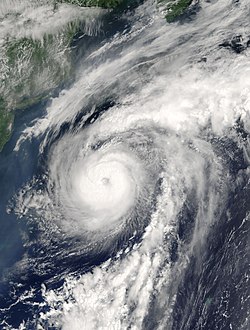Overview
Atlantic Canada has been hit with many storms, with the ones that do hit usually being weak storms, due to the generally cool waters offshore. Some hurricanes can strike the area full force as the warm Gulf Stream extends fairly close to Atlantic Canada. Due to the cool waters for a great distance from the Pacific coast of Canada, there has never been a storm of any intensity to affect the Pacific coast. On occasions, tropical systems can transition into or be absorbed by non-tropical systems that strongly affect Western Canada, most notably by the remnants of Typhoon Freda that were absorbed by the Columbus Day Storm of 1962.
The Canadian Hurricane Centre (CHC) states Hurricane Ella of 1978 is the strongest tropical cyclone in Canadian waters, passing approximately 335 miles (539 km) south of Halifax, Nova Scotia as a Category 4 hurricane. Ella did not make landfall. [1] The strongest hurricane to make landfall in Canada was Hurricane Ginny of 1963, [2] which had winds of 105 mph (169 km/h) and a minimum pressure of 948 millibars (28.0 inHg), making it a Category 2 hurricane at the time of its landfall near Yarmouth, Nova Scotia. [1]
Sometimes, a hurricane will make landfall in the United States and continue northward to dissipate over (or partially over) Canada. Only a handful of storms that have taken this path have been devastating in Canada. Two examples of this happening include the 1900 Galveston hurricane and Hurricane Hazel in 1954. Hurricanes that entered Canada from the U.S. after landfall are omitted from the lists, with being devastating, or notable cyclones. Many extratropical remnants of tropical cyclones have entered Canada. They are not included in the list unless they were particularly notable. This article also includes hurricanes that affected Newfoundland prior to its entry into Canada in 1949, and hurricanes that affected any Canadian provinces before confederation in 1867.
This page is based on this
Wikipedia article Text is available under the
CC BY-SA 4.0 license; additional terms may apply.
Images, videos and audio are available under their respective licenses.




